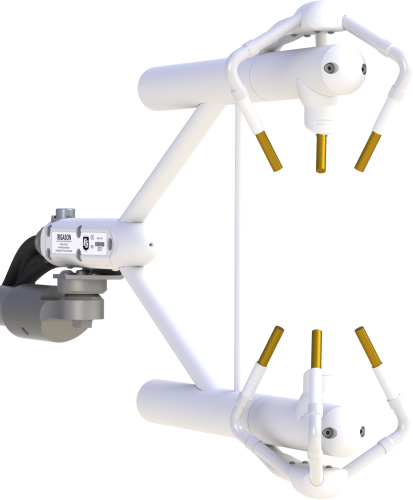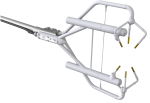
Combines two high-level sensors for eddy-covariance research






Overview
Campbell Scientific’s IRGASON® fully integrates the open-path analyzer and sonic anemometer. Designed specifically for eddy-covariance carbon and water flux measurements, the patented design is easier to install and use than separate sensors and provides increased measurement accuracy. The IRGASON simultaneously measures absolute carbon dioxide and water vapor, air temperature, barometric pressure, three-dimensional wind speed, and sonic air temperature. U.S. patent D680455
For more information about the benefits of having a colocated measurement, refer to the poster "Improved eddy flux measurements by open-path gas analyzer and sonic anemometer co-location."
Read MoreBenefits and Features
- New conformal coating helps protect sonic transducers in corrosive environments
- Combined support structure causes less flow distortion than two separate sensors
- Truly colocated gas analyzer and sonic anemometer measurements avoid flux loss due to sensor separation
- Synchronized gas analyzer and sonic anemometer measurements avoid the need to correct for time lag
- Low power consumption; suitable for solar power applications
- Measurements are temperature compensated without active heat control
- Low noise
- Maximum output rate of 60 Hz with 20 Hz bandwidth
- Angled windows shed water and are tolerant to window contamination
- Field rugged
- Field serviceable
- Factory calibrated over wide range of CO2, H2O, pressure, and temperature in all combinations encountered in practice
- Extensive set of diagnostic parameters
- Fully compatible with Campbell Scientific dataloggers; field setup, configuration, and field zero and span can be accomplished directly from the datalogger
- Sonic temperature determined from three acoustic paths; corrected for crosswind effects
- Innovative signal processing and transducer wicks considerably improve performance of the anemometer during precipitation events
Technical Description
The IRGASON has the following outputs:
- Ux (m/s)
- Uy (m/s)
- Uz (m/s)
- Sonic Temperature (°C)
- Sonic Diagnostic
- CO2 Density (mg/m3)
- H2O Density (g/m3)
- Gas Analyzer Diagnostic
- Ambient Temperature (°C)
- Atmospheric Pressure (kPa)
- CO2 Signal Strength
- H2O Signal Strength
- Source Temperature (°C)
Images

Related Products
Specifications
| Patent | U.S. Patent No. D680455 |
| Operating Temperature Range | -30° to +50°C |
| Calibrated Pressure Range | 70 to 106 kPa |
| Input Voltage Range | 10 to 16 Vdc |
| Power | 5 W (steady state and power up) at 25°C |
| Measurement Rate | 60 Hz |
| Output Bandwidth | 5, 10, 12.5, or 20 Hz (user-programmable) |
| Output Options | SDM, RS-485, USB, analog (CO2 and H2O only) |
| Auxiliary Inputs | Air temperature and pressure |
| Warranty | 3 years or 17,500 hours of operation (whichever comes first) |
| Cable Length | 3 m (10 ft) from IRGASON® to EC100 |
| Weight |
|
Gas Analyzer |
|
| Path Length |
15.37 cm (6.05 in.) A temperature of 20°C and pressure of 101.325 kPa was used to convert mass density to concentration. |
Gas Analyzer - CO2 Performance |
|
| -NOTE- | A temperature of 20°C and pressure of 101.325 kPa was used to convert mass density to concentration. |
| Accuracy |
|
| Precision RMS (maximum) |
0.2 mg/m3 (0.15 μmol/mol) Nominal conditions for precision verification test: 25°C, 86 kPa, 400 μmol/mol CO2, 12°C dewpoint, and 20 Hz bandwidth. |
| Calibrated Range | 0 to 1,000 μmol/mol (0 to 3,000 μmol/mol available upon request.) |
| Zero Drift with Temperature (maximum) | ±0.55 mg/m3/°C (±0.3 μmol/mol/°C) |
| Gain Drift with Temperature (maximum) | ±0.1% of reading/°C |
| Cross Sensitivity (maximum) | ±1.1 x 10-4 mol CO2/mol H2O |
Gas Analyzer - H2O Performance |
|
| -NOTE- | A temperature of 20°C and pressure of 101.325 kPa was used to convert mass density to concentration. |
| Accuracy |
|
| Precision RMS (maximum) |
0.004 g/m3 (0.006 mmol/mol) Nominal conditions for precision verification test: 25°C, 86 kPa, 400 μmol/mol CO2, 12°C dewpoint, and 20 Hz bandwidth. |
| Calibrated Range | 0 to 72 mmol/mol (38°C dewpoint) |
| Zero Drift with Temperature (maximum) | ±0.037 g/m3/°C (±0.05 mmol/mol/°C) |
| Gain Drift with Temperature (maximum) | ±0.3% of reading/°C |
| Cross Sensitivity (maximum) | ±0.1 mol H2O/mol CO2 |
Sonic Anemometer - Accuracy |
|
| -NOTE- | The accuracy specification for the sonic anemometer is for wind speeds < 30 m s-1 and wind angles between ±170°. |
| Offset Error |
|
| Gain Error |
|
| Measurement Precision RMS |
|
| Speed of Sound | Determined from 3 acoustic paths (corrected for crosswind effects) |
| Rain | Innovative signal processing and transducer wicks considerably improve performance of the anemometer during precipitation events. |
Basic Barometer (option -BB) |
|
| Total Accuracy |
|
| Measurement Rate | 10 Hz |
Enhanced Barometer (option -EB) |
|
| Manufacturer | Vaisala PTB110 |
| Total Accuracy | ±0.15 kPa (-30° to +50°C) |
| Measurement Rate | 1 Hz |
Ambient Temperature |
|
| Manufacturer | BetaTherm 100K6A1IA |
| Total Accuracy | ±0.15°C (-30° to +50°C) |
| EC100 ingress protection | IP65 |
Resources and Links
Product Brochures
Manuals
Videos & Tutorials
Downloads
EasyFlux DL for CR6OP v.2.01 (98.2 KB) 21-07-2022
CR6 datalogger program for Campbell open-path eddy-covariance systems.
EC100 OS v.8.02 (560 KB) 14-10-2019
EC100 Operating System.
Watch the Video Tutorial: Updating the EC100 Operating System.
ECMon v.1.6 (10.7 MB) 29-03-2016
EC100-Series Support Software.
Device Configuration Utility v.2.32.01 (47.7 MB) 15-04-2025
A software utility used to download operating systems and set up Campbell Scientific hardware. Also will update PakBus Graph and the Network Planner if they have been installed previously by another Campbell Scientific software package.
Supported Operating Systems:
Windows 11 or 10 (Both 32 and 64 bit)
EasyFlux DL for CR1000XOP v.2.01 (98.2 KB) 21-07-2022
CR1000X datalogger program for Campbell open-path eddy-covariance systems.
FAQs for
Number of FAQs related to IRGASON: 21
Expand AllCollapse All
Case Studies
Understanding the spatial variability of the Earth’s atmospheric boundary layer—including the surface layer near the......read more
Overview In the fight against climate change, innovative solutions are emerging to address the global challenge......read more
The Utah Geological Survey, supported by the Utah Division of Water Rights, has constructed a......read more
The Wolf Creek Dam near Jamestown, Kentucky, was constructed partially as a regular concrete hydroelectric......read more
Articles and Press Releases
Privacy Policy Update
We've updated our privacy policy. Learn More
Cookie Consent
Update your cookie preferences. Update Cookie Preferences










